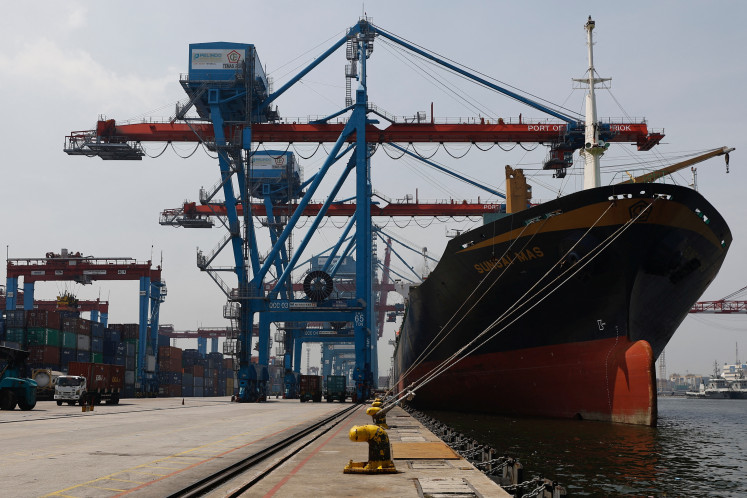ASEAN will be poorer without elephants
From Sumatraâs rain forests to the mountain forests of Indochina, the natural habitats of Southeast Asia are in trouble
Change text size
Gift Premium Articles
to Anyone

F
rom Sumatra's rain forests to the mountain forests of Indochina, the natural habitats of Southeast Asia are in trouble.
Every now and then there is a bit of good news. Last November, a retirement party complete with Buddhist rituals was held for Phnom Penh's beloved pachyderm Sambo. After 30 years of entertaining tourists in Cambodia's capital, Sambo will spend her remaining years with 12 other elephants in the Keo Seima forest located in the country's Mondolkri province.
Unfortunately, much of Southeast Asia's wildlife will never have it as good. From appearances on dinner plates of businessmen seeking to impress clients with exotic fare, to forced performances at dubious wildlife parks before ever growing numbers of tourists, Southeast Asia's indigenous animals are increasingly under threat.
The Rainforest Action Network, a California-based environmental organization, says the rapid loss of Indonesia's biologically rich and diverse rainforests is driving numerous species to the very edge of survival.
In Vietnam, the pangolin ' a scaly anteater-like mammal often described as Asia's most trafficked animal ' is being hunted down for food there as well as for illegal export to China.
And in Thailand, the government recently seized six protected Asian black bears from a well-known Buddhist temple in Kanchanaburi nicknamed 'Tiger Temple' for the now more than 145 tigers also housed there. A standoff continues between the Thai Department of National Park, Wildlife and Plant Conservation and the temple's monks and staff over the plight of the tigers. According to the Bangkok Post, complaints have been made that the temple was linked to wildlife trafficking and possible maltreatment of animals.
Yet, it is the iconic Southeast Asian elephant that is being killed for its ivory, meat and body parts. The destruction and fragmentation of the animal's natural habitat and disruption of migratory routes by logging and agri-plantations have led to deadly encounters and the killing of elephants.
At one time, the Asian elephant could be found in large numbers as far west as the Tigris and Euphrates rivers, in the Indian subcontinent, throughout Southeast Asia, and into China. At the beginning of the 20th century, hundreds of thousands of wild elephants may have lived in Asia.
Today, the International Union for Conservation of Nature (IUCN) classifies the Asian elephant as endangered, with no more than 50,000 living in isolated populations across the region. The World Wild Fund for Nature estimates that the number is much lower ' with no more than 25,000 living in the wild.
The overall population decline of the Asian elephant is most evident in Southeast Asia. The IUCN estimates the wild elephant population size in Cambodia to be between 250 to 600; Indonesia 2,400 to 3,400; Laos 500 to 1,000; Malaysia 2,100 to 3,100; Myanmar 4,000 to 5,000; Thailand 2,500 to 3,200; and Vietnam 70 to 150.
This is a sad state of affairs for an animal that has historically held a revered position throughout the ASEAN region. Laos was once referred to as the 'land of a million elephants'. And during the late 1800s, a white elephant featured prominently on Thailand's national flag. The elephant has worked the agricultural fields, fought alongside warrior kings, and help give rise to Southeast Asia's great civilizations.
So, is there hope for Asia's elephants? How to ensure the elephant does not go the way of the now extinct Bali Tiger?
First, field research is necessary to better determine how many elephants live in the wild and their living habits. Present population figures, according to the ICUN, are at best, 'guesstimates', of the true number of wild elephants. Accurate data will yield dividends regarding how to best design programs to protect Southeast Asia's remaining elephants.
Second, ASEAN governments need stronger legislation and enforcement against poaching and the illegal ivory trade. Here, China must also step up given the outsized role of the Chinese consumer in the demand for elephant and other wildlife products. Recently, more than 700 ivory tusks from African elephants were seized at Bangkok's airport, en route to Laos and likely onward to China.
At the moment, lax enforcement of existing laws, particularly in the 'Golden Triangle' area encompassing Laos, Thailand, and Myanmar, has made this region a hub for the sale of ivory and elephant body parts. This needs to stop.
Third, as Southeast Asia's long tradition of domesticated elephants fades, the capture of juvenile elephants for tourism purposes must be halted. According to the American Museum of Natural History, elephants performing for tourists may have been violently separated from their families at a very young age. In turn, the life they might well go on to live is no way to treat a domesticated animal, much less a wild one.
Finally, we need to acknowledge that what elephants truly need is space to survive. This means creating elephant sanctuaries, such as the Elephant Valley Project, a Cambodian ecotourism projected funded in part by the United States Agency for International Development, and where Sambo currently resides. Buffer zones also need to be established around economic hubs to decrease human-elephant conflict.
None of this is easy particularly as nations in the region struggle to develop their economies to improve their citizen's standard of living. But, whether tigers or elephants, Asia and ASEAN in particular would be a poorer place without them.
_______________________
Jose B. Collazo is a Southeast Asia analyst and an associate at advisory firm RiverPeak Group. Curtis S. Chin, a former US ambassador to the Asian Development Bank, is managing director of RiverPeak Group. The views expressed are their own.









